There are numerous ways to improve the appearance and quality of life within your home. Here are several home improvement ideas that you will most certainly like and even consider to implement in your household.
- Aquarium bed – Although this idea may sound a bit childish if you are a grown up, it is still an amazing home improvement that will certainly alter the overall ambiance of your home or at least your bedroom. On the other hand if you aren’t still convinced that you should place an aquarium bed in your bedroom, you can always consider placing one in your kid’s room.
- Forest Chandelier – At first glance this chandelier is a cube or sphere made of randomly put together piece of white wires. However when you turn on the light, it becomes magical, as the light illuminates the wires which create tree-like shadows on the walls. This home improvement is not only cheap but it will also instantly convert your living room chandelier into an excellent conversation piece.
- Sand under your desk – Do you work at home? Do you like the feeling of sand under your naked feet? If the answer to both these questions is yes, then you shouldn’t wait a minute longer to install a sand box under your desk. This way you will be able to work in full comfort while you seek as sunk into the gently touch of the sand which you have poured into the sand box.
- Spiral staircase slide – Spiral staircases are classy and add a sophisticated touch to any household. However such staircases can also been hazardous, especially towards children. So if you have enough room around the staircase you should consider mounting a spiral staircase slide. This way you and your children can have fun while you are going down the stairs.
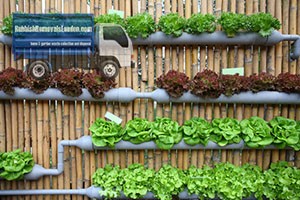 Vertical garden – Who says that you must have an immense backyard to have your own herb garden? Instead you can place a vertical garden on one of your kitchen walls and use it to grow your own herbs.
Vertical garden – Who says that you must have an immense backyard to have your own herb garden? Instead you can place a vertical garden on one of your kitchen walls and use it to grow your own herbs.- Walk-in pool – It is beyond any doubt that walk-in pools are an amazing addition to any backyard. So instead of opting for a traditional rectangular pool, opt for a walk-in pool. The pool will give you the feeling that you are entering into the sea, ocean or lake and will automatically increase the ambiance and value of your property.
- Stair hammock – Do you know that space over your staircase which you cannot use? Well now you can by placing a stair hammock. You can use the hammock to either sleep on it or read a nice book in full comfort.
Regardless which of these seven home improvement projects you choose for your home, make sure that you book in advance a company that provides junk clearances. You will need such services because the volume of accumulated rubbish will be too grand for you to clear it on your own. Know that nowadays most junk clearance companies work with cost effective prices, so have no worries that you may have to break bank in order to benefit from such services.
Once the rubbish is removed, start enjoying the home improvement that you have made to your home.
Who says that you must use your attic to store unnecessary items? The truth is that you can use your attic in any way that you want and if you keep reading we will present to you several functional room designs which you can use to convert your attic into more than a storage room.
Retreat suit:
You can easily convert your attic into a space of rest and relaxation by painting the walls in a neutral color such as white or beige and covering the floor with a wall-to-wall carpet that compliments the color of the walls. Then simply place a bed or a couch and arm chairs set in there and voila, you will have an R&R room in which you can retreat away from all the noises of your household and have a little bit of time for yourself and relax and recharge the batteries.
Homework area:
Your children’s room should be their private area where they can retreat and do whatever they want to after a long day at school. So instead of placing a desk in their room as a constant reminder that they have homework to do, why don’t you convert your attic into a homework area? Simply paint the walls in vibrant and playful tones and arrange a desk or two (in dependence of the number of kids that you have) with computers and all necessary materials for your children to do their homework and learn their lessons. By doing so your children will have both a room to rest and relax and a room for more serious tasks.
Playroom:
The principal behind this design is the same as the one for above with the sole difference that this time you will convert the attic into a room where your children can retreat and plays their favorite games and video games with their friends. For the task, paint the wall in bright colors and mount a television on one of the walls. Then place several bean bags throughout the room and stock the shelves of the attic with numerous board games and video games.
Man cave:
Every man wants to have his man cave where he can gather with his buddies and watch the weekend matches. So instead of converting your garage or basement, why don’t you consider transforming your attic into your own masculine area? This way you will be able to watch your football games without having to worry that your lady is getting irritated by the fact that you are a television hog.
Regardless which design you choose, make sure that you book in advance a company that provides rubbish removals because you will need such once you are done with your attic transformation project. Don’t worry about the price of waste clearance services because nowadays most rubbish removal companies work with cost effective prices that literally anyone could afford.
Once that the waste is removed from your property, head to your attic and enjoy with your family the newest addition towards your household.
Currently, Europe uses a special technology which converts cellulosic wastes and residue into quality and efficient biofuel. Biofuel derived through this method is expected to cover up to twenty percent of the continent’s transport fuel consumption needs by the year twenty thirty. According to a report by the International Council on Clean Transportation, biofuel produced in this way will reduce overall greenhouse emissions by sixty percent.
Using biofuel on a wider scale is going to be beneficial for Europe on many levels. The ICCT, which is a non-profit, independent organisation providing unbiased data and analysis to governments and companies projects that by cutting the carbon intensive use of transport fuels will reduce national spending on oil imports, it will also boost economy in rural areas of countries where biofuels can be produced from residues and wastes.
One key problem outlined by the ICCT report is the lack of sufficient amount of wastes and residues to produce cost effective quantities of transport biofuels. This however doesn’t mean that people should produce more waste just so they power transport using biofuels, but rather to focus on more efficient collection and processing methods which yield more fuel from existing amounts of waste. One of the most important advantages of using biofuel for transport is the sizeable reduction of oil import costs. Europe imports fair bit of its oil, and using biofuels instead will make a tremendous difference.
 Production and use of biofuels is necessary in many respects. ICCT says that if all sustainable resources available to partner countries in the EU are efficiently reprocessed into biofuel, a certain sixteen percent of demand will be covered by biofuels by the year two thousand thirty. It is also important to consider the many new jobs which will open on a local and national level as processing plants and refineries would have to be sufficiently staffed. It is expected for thousands of new jobs to be created in waste collection, as well as construction and operation of treatment and production sites. In figures, it is estimated that sustainable production of biofuel will create about three hundred thousand new jobs, and pour in about fifteen billion Euro of additional revenue in countries’ rural economies, and all of it by the year two thousand thirty!
Production and use of biofuels is necessary in many respects. ICCT says that if all sustainable resources available to partner countries in the EU are efficiently reprocessed into biofuel, a certain sixteen percent of demand will be covered by biofuels by the year two thousand thirty. It is also important to consider the many new jobs which will open on a local and national level as processing plants and refineries would have to be sufficiently staffed. It is expected for thousands of new jobs to be created in waste collection, as well as construction and operation of treatment and production sites. In figures, it is estimated that sustainable production of biofuel will create about three hundred thousand new jobs, and pour in about fifteen billion Euro of additional revenue in countries’ rural economies, and all of it by the year two thousand thirty!
The EU has some of the strictest climate goals in the world. In light of this, production and use of biofuel will prove very important and help reduce C02 emissions anywhere between sixty and eighty five percent. One very important aspect of biofuel production is sustainability and preservation of the environment. In other words, production of biofuels should not pollute or contaminate which is the case with most types of conventional production and manufacturing.
It is expected for biofuel production to require very little incentive as the main feedstock for production would be residues and wastes from sustainable sources. Different production methods vary in competitiveness and cost efficiency, but on a larger scale most biofuel production techniques require only solid, long-term policy and commitment on behalf of governments.
Recently, a rather worrying report by the London Assembly Environment Committee has come out stating that available space in landfills is quickly running out, in order to countermeasure the situation, urgent steps must be taken by London waste management authorities, particularly toward dealing effectively with food waste and scraps.
Statistics show that each year, Londoners throw out seven tonnes of food waste and scraps. In light of this the report focuses on more efficient domestic waste collection practices on a local level, and more efficient food waste management on a metropolitan level. The report also suggests possible strategies on how to optimise collection and management given the local specifics faced by each borough council.
The report states that only twenty three out of thirty three London boroughs actually maintain and provide a specialised collection and disposal service for food waste. Sixteen of the boroughs did not have a separated waste collection service for flats at all. It turns out more than half of London’s households are left without the option to recycle.
At the moment, food waste accounts for about twenty percent of all waste collected from households. The Committee report says that local authorities should devise and implement separate collection and disposal service regardless of what kind of property. Doing so will increase London’s recycling capacity quite notably as the city’s recycling rate is quite sluggish and has been for a while (compared to other cities in EU and the rest of the world).
It is surprising that London has proper waste collection and management practices for ‘dry recyclables’ like paper, plastic, metal, wood, glass etc. but only a few places have a separate food waste collection and disposal service. Only half of all London households have access to a specialised food waste management program provided by local authorities.
 At the same time, London’s sluggish recycling rate and the fact that the city is quickly running out of landfill space makes addressing the food waste collection and management issue even more urgent. The report proposes for government funding to be secured and used for creating effective food waste management programs for all boroughs of the capital. The report urges the Mayor of London to initiate, support and popularise the proposed solutions as this would be invaluable in terms of educating the public and help meet London’s recycling targets.
At the same time, London’s sluggish recycling rate and the fact that the city is quickly running out of landfill space makes addressing the food waste collection and management issue even more urgent. The report proposes for government funding to be secured and used for creating effective food waste management programs for all boroughs of the capital. The report urges the Mayor of London to initiate, support and popularise the proposed solutions as this would be invaluable in terms of educating the public and help meet London’s recycling targets.
The implemented solutions should be long term, not band aid. This means that more waste processing facilities would be needed as London’s growing population increases waste production by extra one million tonnes (projected over the next couple of years or so). Currently, half of all food waste collected throughout the city is composted in special anaerobic digestion facilities outside Greater London.
One portion of the city where recycling rates are next to none is Inner London. This part of the city recycles mere sixteen percent of all waste collected, which makes London’s overall recycling rate of thirty four percent seem like a real achievement. Figures show something must be done quickly.
Reusing useful rubbish through reprocessing which is what recycling is, has been around for many centuries as a concept and practice. With time, and with the industrial development of the world, it became apparent that metal junk (later known technically as scrap metal) was one of the most useful types of rubbish as it provided the base ingredient for production of new raw materials and metals.
The fact that scrap metal quickly became the most valuable type of rubbish should come as no surprise as back in those days, consumer society and mass production were unknown as concepts. There was no excess consumption of products and raw materials as manufacturing was very limited and focused on machinery. Plus, plastics were quite some time from being discovered as chemistry was a long way from generating such molecules and substances.
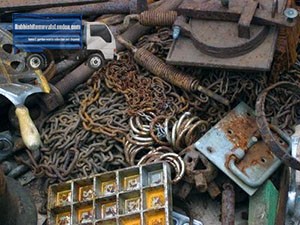 The first types of metal rubbish to be collected and recycled through organised means were household items and machinery scrap from factories. In the US, a few years before the outbreak of WWI, there were people called peddlers who collected all types of metal junk and then sold it on for recycling. In the UK, some manufacturers recycled metal bottle caps as early as the start of the eighteenth century, particularly Schweppes. The first official recycling system with refundable deposits was devised and implemented in Sweden in the late eighteen hundreds.
The first types of metal rubbish to be collected and recycled through organised means were household items and machinery scrap from factories. In the US, a few years before the outbreak of WWI, there were people called peddlers who collected all types of metal junk and then sold it on for recycling. In the UK, some manufacturers recycled metal bottle caps as early as the start of the eighteenth century, particularly Schweppes. The first official recycling system with refundable deposits was devised and implemented in Sweden in the late eighteen hundreds.
During the first and second world wars, particularly WWII, recycling of metal junk was the thing to do. In wartime, when countries are experiencing significant raw material shortages and manufacturing efforts are engaged by the military complex, it was more than necessary to reuse and recycle all sorts of different rubbish, including of course scrap metal. The fact that civilian population, was suffering from shortages of materials and items during wartime was also a key drive for developing effective recycling and reuse practices. Households quickly realised that reusing whatever useful rubbish there is, will make a notable difference in their day to day life, especially in the grip of wartime struggles.
Recycling rubbish and junk, especially scrap metal was also a matter of ideology. In times of war, people were told that victory to large extent, depended on the availability of raw materials and scrap metal which is vitally needed by wartime manufacturing. During WWII the Allies were simultaneously running home front campaigns in which civilian population was strongly urged to donate scrap metal and other useful rubbish as a matter of patriotism.
One of the most popular and recognisable posters from WWII Great Britain actually urged civilian population to collect, store and donate as much rags, bones and paper as possible. These might seem unsuitable in terms of recycling purpose, but such materials were pretty much just as important for the wartime effort as metals were. One of the US posters to urge civilians to donate salvageable metal rubbish actually depicted different types of metal, and how citizens should separate different kinds of scrap metal from one another, one of the posters actually said: ‘Don’t Mix it!’
For years now London has been the greenest city in Europe of its size. No other major capital or town of equal or near proportions has better environment protection policies, more adequate rubbish collection and disposal strategies and the sheer will of local councils to enter the 21st century with the sense of responsibility towards nature than London.
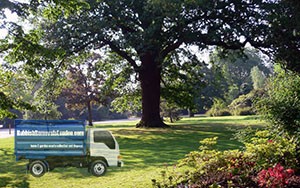 There are many studies that come to back up those claims. The first one was conducted in 2013 under the commission of City of London Corporation, but many more followed with the same results – London is on the top of the list in Europe and is one of the three most environment responsible cities in the world as a whole.
There are many studies that come to back up those claims. The first one was conducted in 2013 under the commission of City of London Corporation, but many more followed with the same results – London is on the top of the list in Europe and is one of the three most environment responsible cities in the world as a whole.
Some of the reasons London is way ahead of the other European cities of its dimensions have already been mentioned in the first paragraph. One that went unsaid is the fact that indeed London is literally the greenest of them all. According to the most recent estimates the capital of Britain has over 35 000 acres of open spaces and parks, woodlands and public gardens. This is an astonishing number that was certainly double and triple-checked by the conductors of the survey, because the numbers show over 40% of the territory of the metropolis is actually covered by publically accessible open green spaces. If you want to imagine better how big this is, consider the fact that the second European city on the list – the capital of Germany Berlin, can boast only mere 14.4 % of open green surface area.
But why are public green spaces so important? Well, for one thing they have very positive effect on the fight against climate change. They absorb pollution from the atmosphere, reduce flooding and generally improve the quality of the air that residents and visitors to London breathe.
The presence of open green spaces in London is important not only because of environmental reasons however. Recent studies show that people’s productivity increases if they have access to green areas like parks and gardens, which definitely leads to economic benefits for the city as a whole.
Parks and woodlands are major tourist attractions that boost significantly local economies, which is one practical reason more why keeping the quantity of such spaces in London would be not only good, but also rather advisable. For example, only the parks and spaces that are managed by the City of London Corporation have estimated 23 million visitors for the 2012/2013 period. You do the math.
What does all of that mean? London is by far one of the most important financial and commercial centers in the world. It is also one of the biggest cities currently in existence. In general terms the presence of so many and so large open green spaces in the capital however also means that it is also one of the best place to live in the world. A fact that you should be pretty happy about in case you are based here.
This is a continuation of the list of hotly debated and turbulent incinerator projects proposed for construction in and around London. As mentioned earlier, burning junk and rubbish from homes and businesses is not the best waste management solution in the world, but it is a much better alternative to landfills or similar rubbish management practices – at least it creates power and heat if anything.
Willesden Junction EFW Plant, also known as ACTF or Willesden Junction Freight Terminal Site is a hundred and twenty eight thousand ton pyrolysis incinerator. When in use, it is expected for the incinerator to generate eight megawatts of power through ACT which stands for advances combustion technology. Planning permission has not been granted yet (although submitted in twenty twelve) as the proposed incinerator site could end up being part of the London High Speed 2 Project. So far, there is no further processing of the application, though the project is not cancelled.
Sutton Waste Management Facility in South London is going to be a decent sized junk and rubbish incinerator with a two hundred and seventy five thousand ton processing capacity. Planning permission for the facility was given in twenty thirteen. The incinerator is intended to be a long-term municipal waste management facility chiefly serving the boroughs of Merton, Sutton and Kingston.
Another junk and rubbish incinerator in South London is the still-nameless site known as Rear of 87 Beddington Lane. This is likely to be a gasification type incinerator with hundred and fifty thousand ton waste processing capacity. It is expected to be an Advanced Thermal Treatment facility – a special type of incinerator processing biomass waste and low-grade waste wood. Planning permission for the facility was given in twenty fourteen, however this has nothing to do with the other waste processing plant due for construction in the same district.
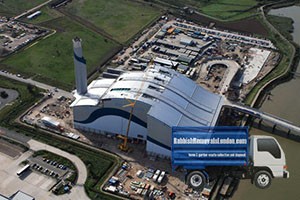 One of the South East London waste processing sites to be in operation already is the Belvedere Incinerator. The treatment plant has quite a formidable processing capacity – seven hundred thousand tons. Belvedere Incinerator was one of the first to be funded and constructed through the EfW (energy for waste) Initiative. The site operator has signed a twenty five year contract with local authorities to treat up to seventy thousand tons of residual waste per annum. Up until three years ago, the plant had burnt nearly four hundred thousand tons of junk and rubbish.
One of the South East London waste processing sites to be in operation already is the Belvedere Incinerator. The treatment plant has quite a formidable processing capacity – seven hundred thousand tons. Belvedere Incinerator was one of the first to be funded and constructed through the EfW (energy for waste) Initiative. The site operator has signed a twenty five year contract with local authorities to treat up to seventy thousand tons of residual waste per annum. Up until three years ago, the plant had burnt nearly four hundred thousand tons of junk and rubbish.
SELCHP is South East London, also known as the Kennels Site, is operated by South East London Combined Heat & Power Ltd. (SELCHP). The incinerator has nearly half a million ton processing capacity and has been in operation since two thousand six. From two thousand six, to two thousand nine alone, the facility had burnt nearly five million tons of waste.
Tate & Lyle Sugar Refinery Site in East London is also the proposed location of a rubbish incinerator operated by a company called Covanta. The facility which is to have about three hundred thousand tons of processing capacity is expected to be a SRF burning incinerator. At his point there are quite a few issues and complications with permits, application withdrawals etc. concerning the project.
The existence and use of waste incinerators is one of those highly debated issues which plague many large cities around the world, including the British Capital. Waste incinerators are basically massive furnaces which burnt junk and rubbish under controlled conditions.
The first problem with incinerators is that they do indeed reduce waste in size and volume, but they don’t necessarily reduce pollution that much since burning waste creates fumes and vapours. Although these are filtered and degraded as much as possible, a certain amount of pollution is expelled in the atmosphere.
One the other hand, waste incinerators are a much better alternative to landfills. Landfills will eventually poison the earth and its water resources, not matter how clever they are constructed, or how well situated geographically. Plus, landfills do not reduce waste in volume, they just hide it from view. Another benefit of incinerators which must be noted is the fact that they do create heat and energy for homes and businesses – again, not the best option to generate such resources, but better than plainly burning fossil fuels.
At the moment there are many active junk and rubbish incinerators around London. There are also some which are still pending completion or still in the process of applying for planning permission from authorities. It is natural for local communities and conservation groups to oppose construction and use of junk and rubbish incinerators but so far there has been no viable alternative proposed.
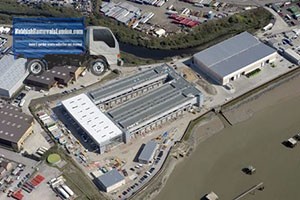 In East London, there is the Frog Island Incinerator also known as East London Sustainable Energy Facility. The plant has hundred and thirty thousand ton capacity. This particular facility is a pyrolysis/gasification type incinerator intended to burn solid recovered fuels collected from municipalities. The gasification plant of the incinerator is permitted to burn SRF from municipal waste.
In East London, there is the Frog Island Incinerator also known as East London Sustainable Energy Facility. The plant has hundred and thirty thousand ton capacity. This particular facility is a pyrolysis/gasification type incinerator intended to burn solid recovered fuels collected from municipalities. The gasification plant of the incinerator is permitted to burn SRF from municipal waste.
Also in East London, though still pending construction is Green Sky London. When finished this waste incinerator will have five hundred thousand tons of processing capacity. This is a gasification class facility intended to produce jet fuels for BA from junk and rubbish collected in London. At the moment, there is no site selected, although the construction for the project was due to begin in the current twenty fifteen.
Thames Gateway Energy Facility, again in East London is a gasification type incinerator with a waste processing capacity of hundred and twenty thousand tons. It is intended to treat C&I (commercial and industrial) waste. The project was given planning permission by authorities in twenty eleven, apparently construction has commenced in twenty twelve.
Currently in North London there is the Edmonton Solid Waste Incinerator in operation. It is proposed for a new facility called Edmonton EcoPark to replace the existing incinerator by the year two thousand twenty five. The new facility is supposed to have seven hundred thousand ton waste processing capacity. However the project is still in its consultation and discussion stage.
Also in North London, there are plans to construct a gasification type incinerator which is still simply referred to as Brent Cross or Barnet Incinerator. When finished it is supposed to have a hundred and thirty thousand ton waste processing capacity separated for both domestic and commercial rubbish. Planning permission for the facility was given in twenty fourteen.
No matter how big your kitchen is, you will always complain about the lack of storage. However there are ways to solve your storage problems and here are some of them.
- Add more freestanding pieces– By doing so you will compensate the lack of kitchen cabinets that you need to store everything that you have in your kitchen. For instance you can place a freestanding kitchen armoire in one corner of your kitchen and keep all your china, dishware and utensils in it. This way you will open enough space in your kitchen cabinets to store more food products.
- Mount open shelves – It is a proven fact that open shelves can store more items can cabinets. So don’t be hesitant to mount several open shelves on one of your kitchen walls. This way you will not only enhance the storage capacity of your kitchen but give to the room a more interesting mood as open shelves are becoming more and more popular amongst homeowners. Once you are done mounting the shelves, call a junk removal company to clear of the rubbish for you. It is for the best if you use such services are you will be too tired to conduct this task on our own.
- Use the cabinet doors – Do you know that you can use the back of your cabinet doors to store small items such as salt and pepper shakers? Simply mount over the door wire organizers on the back of the doors and voila you will have more space to store the smallest items that you keep in your kitchen.
 Convert the bottom of your kitchen cabinetry – All kitchen cabinets have a wooden frame on which they stand. So why don’t you convert the wooden frame into several drawers in which you can keep the not so essential things. Note that his conversion project will certainly generate immense amount of waste, so make sure that you book the services of a company that provide junk removals before you commence your project. Have no worries that you may not be able to book such services, because lots of waste clearance companies work with flexible work schedules and even more tend to accept last minute bookings.
Convert the bottom of your kitchen cabinetry – All kitchen cabinets have a wooden frame on which they stand. So why don’t you convert the wooden frame into several drawers in which you can keep the not so essential things. Note that his conversion project will certainly generate immense amount of waste, so make sure that you book the services of a company that provide junk removals before you commence your project. Have no worries that you may not be able to book such services, because lots of waste clearance companies work with flexible work schedules and even more tend to accept last minute bookings.- Use the side of a fridge cabinet – If you have a fridge cabinet you can easily use its side as a bulletin board by hanging several build-in bins on it. This way you will convert this section of your kitchen into a command centre where you will keep all the information about the meals that you are planning to cook, the groceries that are to be made and etc.
- Use the air space – Most people don’t place shelves higher than their reach. The truth is that all this unused space can be used for storage purposes. So add shelves up to the ceiling. Simply keep the essential things on the lower shelves and the not so important things on the upper shelves.
Now that you know these six solutions for your kitchen storage problems, don’t wait a minute longer to implement them into your kitchen and solve all your problems.
You don’t need to break bank in order to give a newer and fresher look to your kitchen. If you are considering remodeling your kitchen here are several inexpensive suggestions that you can decide to implement into your remodeling project and change the appearance of your kitchen drastically.
A simple and yet very effective and inexpensive way to change the overall style of your kitchen is to repaint the cabinetry. For instance if you current cabinets are painted in a light color, repaint them in a darker tone. The darker tone will quickly change the mood of the room.
Another cheap remodeling project that involves altering your kitchen cabinetry is to remove several cabinet doors. By doing so you will not only change the ambiance of your kitchen but also create the illusion that your kitchen is much larger. If you don’t want to remove the doors from your cabinet you can always embellish them. Simply cut several holes into the doors with a jigsaw and then fill the holes with glass, wire or metal mesh inserts. This will not only change the style of your kitchen but also add a more artistic touch to it.
 If you don’t want to change the overall style of your kitchen cabinetry by repainting them or altering with the doors, then simply replace all the door knobs and drawer pulls with new ones. You will be amazed how much this small and cheap remodeling trick will affect the overall feeling of your kitchen. You can augment even more the new feeling of your kitchen if you replace your current sink faucet with a new one.
If you don’t want to change the overall style of your kitchen cabinetry by repainting them or altering with the doors, then simply replace all the door knobs and drawer pulls with new ones. You will be amazed how much this small and cheap remodeling trick will affect the overall feeling of your kitchen. You can augment even more the new feeling of your kitchen if you replace your current sink faucet with a new one.
You can also change the appearance of your kitchen by giving a facelift to your kitchen countertops. Instead of replacing your countertops completely simple glue some ceramic or stone tile or wooden pieces on them. The new features will give a more sophisticated look to your kitchen countertops which will automatically affect the entire room.
If you have kitchen cabinetry with glass doors, consider replacing the glassware and china that you keep in the cabinets. By changing them you will change the entire mood of the room.
Our last suggestion is that you repaint the walls of your kitchen and replacing the window curtains. These two simple changes will effect dramatically on the ambiance of the room and we promise you that at the beginning you will feel as if you are entering in somebody else’s kitchen.
As you can see there are many inexpensive ways by which you can remodel and enhance the appearance of your kitchen. Once done with the remodeling use professional rubbish removal services to clear the accumulated junk. You will need the services of a rubbish removal company because you will be too tired to collect and disposal of the waste on your own.
Know that nowadays most waste clearance companies work with affordable prices, so don’t worry that your saving may be drained if you use such services.


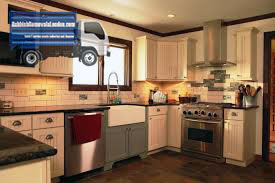 Convert the bottom of your kitchen cabinetry
Convert the bottom of your kitchen cabinetry